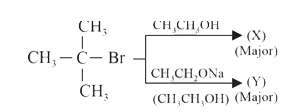Hydrolysis of SiCl4 gives compound 'X' and HCl on heating to 1000∘C 'X' loses water and forms 'Y'. Identify 'X' and 'Y' respectively.
SiO2 and Si
H4SiO4 and SiO2
SiO2 and SiC
H4SiO4 and SiC
To solve the problem step by step, we will analyze the hydrolysis of SiCl₄ and the subsequent heating process.
Step 1: Hydrolysis of SiCl₄
When silicon tetrachloride (SiCl₄) undergoes hydrolysis, it reacts with water (H₂O) to form a compound and hydrochloric acid (HCl). The reaction can be written as follows:
SiCl4+4H2O→Si(OH)4+4HCl
Here, the compound formed is Silicic acid, which has the formula Si(OH)₄.
Step 2: Identify Compound X
From the above reaction, we can identify compound X as:
X=Si(OH)4
Step 3: Heating Compound X
Next, we need to heat compound X (Si(OH)₄) to 1000°C. During this heating process, Si(OH)₄ loses water (H₂O) to form another compound. The reaction can be represented as:
Si(OH)4→SiO2+2H2O
Step 4: Identify Compound Y
After heating, the compound formed is silicon dioxide (SiO₂). Therefore, we can identify compound Y as:
Y=SiO2
Final Answer
Thus, the compounds X and Y are:
- X = Si(OH)₄ (Silicic acid)
- Y = SiO₂ (Silicon dioxide)
Summary
- X = Si(OH)₄
- Y = SiO₂
When silicon tetrachloride (SiCl₄) undergoes hydrolysis, it reacts with water (H₂O) to form a compound and hydrochloric acid (HCl). The reaction can be written as follows:
From the above reaction, we can identify compound X as:
Next, we need to heat compound X (Si(OH)₄) to 1000°C. During this heating process, Si(OH)₄ loses water (H₂O) to form another compound. The reaction can be represented as:
After heating, the compound formed is silicon dioxide (SiO₂). Therefore, we can identify compound Y as:
Thus, the compounds X and Y are:
- X = Si(OH)₄ (Silicic acid)
- Y = SiO₂ (Silicon dioxide)
- X = Si(OH)₄
- Y = SiO₂
Topper's Solved these Questions
- p-BLOCK ELEMENTS-1BOOK - VMC MODULES ENGLISHCHAPTER - p-BLOCK ELEMENTS-1EXERCISE - LEVEL 2
73 Videos
- p-BLOCK ELEMENTS-1BOOK - VMC MODULES ENGLISHCHAPTER - p-BLOCK ELEMENTS-1EXERCISE - JEE Main Archive
34 Videos
- p-BLOCK ELEMENTS-1BOOK - VMC MODULES ENGLISHCHAPTER - p-BLOCK ELEMENTS-1EXERCISE - JEE Advanced Archive
48 Videos
- MOCK TEST 9BOOK - VMC MODULES ENGLISHCHAPTER - MOCK TEST 9EXERCISE - CHEMISTRY (SECTION 2)
5 Videos
- PERIODIC PROPERTIES OF ELEMENTSBOOK - VMC MODULES ENGLISHCHAPTER - PERIODIC PROPERTIES OF ELEMENTSEXERCISE - IMPECCABLE
50 Videos
Similar Questions
A sample of air which is free from CO2, is used to heat Na metal at 350∘C to form X. X has the property to absorb CO2 and form Y. Identify ''X'' and ''Y'' respectively.
View SolutionXenon hexafluoride on partial hydrolysis produces compounds 'X' and 'Y' . Compounds 'X' and 'Y' and the oxidation state of Xe are respectively :
View Solution
Knowledge Check
Two unknown compounds X and Y, both having molecular formula C4HgO, give following results with four chemical tests.

Compound X and Y respectively are :A B
B C
C D
D
A hydrated solid X on heating initally gives a monohydrated compound Y. Y upon heating above 373 K leads to an anhydrous white powder Z, X and Z respectively, are:
View SolutionA hydrated solid X on heating initally gives a monohydrated compound Y. Y upon heating above 373 K leads to an anhydrous white powder Z, X and Z respectively, are:
View SolutionGlycerol reacts with 3 moles of HI to form 'X' and excess of HI to form Y. Here 'Y' and 'X' are respectively
View SolutionKMnO4 in excess on treatment with concentrated H2SO4 forms a compound (X) which decomposes explosively on heating forming (Y). The (X) and (Y) are respectively.
View SolutionAn organic compound 'X' with molecular formula C7H8O in insoluble in aqueous NaHCO3 but dissolved in NaOH. When treated with bromine water 'X' rapidly give 'Y' (C7H5OBr). The compound 'X' and 'Y' respectively are
View Solution Identify (X) and (Y) formed in the given reaction.
Identify (X) and (Y) formed in the given reaction.
View SolutionBoric acid on heating at 100∘C, gives (X). (X) on heating at 160∘C gives (Y) and (Y) on heating at red hot gives (Z). Identify (X),(Y) and (Z).
View Solution
